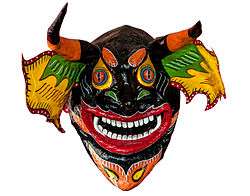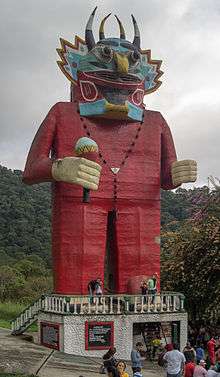Dancing devils of Corpus Christi
| Diablos Danzantes de Venezuela | |
|---|---|
 | |
| Country | Venezuela |
| Reference | 00 |
| Region | América Latina y el Caribe |
| Inscription history | |
| Inscription | 2012 |

Dancing Devils of Corpus Christi refers to a set of popular Venezuelan religious festivals held in Corpus Christi in various regions by different groups, which make brotherhoods celebrating Christ's presence in the Blessed Sacrament of the Eucharist,[1] according to the Catholic doctrine. It generally refers to 11 brotherhoods that include more than 5,000 people,[2] among which the best known is the Dancing Devils of Yare. These manifestations were recognized by UNESCO as Intangible Cultural Heritage in 2012.
History
The brotherhood groups originated in the mid seventeenth century[3] on the Aragua and Vargas[2] state farms. It is known that as early as 1749, Corpus Christi was celebrated and men, women and children dressed as devils to fulfill promises made to the Blessed Sacrament.[4]
Although we cannot determine a unique and certain origin, the Dancing Devils of Corpus Christi have been attributed to different origins. According to oral tradition, a story about the San Francisco de Yare brotherhood says that 400 years ago, a priest without money or believers to be able to hold the procession of Corpus Christi said: "If there is no money nor believers to carry the Blessed Sacrament in procession, then the devils come!"[5] After a storm, several devils presented themselves in front of the church.[6]
Regarding other stories about the Yare brotherhoods are, some references are in the novel Peonía by the writer Manuel Vicente Romero Garcia, describing in a clear and illustrative manner how the dancers were Cúa devils in the 1870s.[7]
Brotherhoods
There are 11 groups[8] recognized as guilds, societies or associations which constitute hierarchies to dance annually and make promises to worship the Blessed Sacrament.[9][10] All of them are independent organizations established in their respective communities. In contemporary times, groups have organized non-profit associations that access public and private funding to improve their organizational strategies and promote reaching a wider audience.[3]
- #Dancing Devils of Yare
- Dancing Devils of Ocumare de la Costa
- Dancing Devils of Cata
- Dancing Devils of Cuyagua
- Dancing Devils of Turiamo
- Dancing Devils of Chuao
- Dancing Devils of Patanemo
- Dancing Devils of San Rafael de Orituco
- Dancing Devils of Tinaquillo
- Dancing Devils of San Millán
- Dancing Devils of Naiguatá
Trying to reach a degree of organizational strength, several fraternities held a series of "national meetings," each located in a different community. As a result, the National Association of Dancing Devils of Corpus Christi was created to bring together most of the existing fraternities.[3]
Yare
The Dancing Devils of Yare (Diablos Danzantes del Yare) is the name of a religious festival celebrated in San Francisco de Yare, in the state of Miranda, Venezuela, on the day of Corpus Christi. The Sociedades del Santísimo (Societies of the Holiest) are in charge of the celebration. Its origins are traced back to the 18th century, being the oldest brotherhood of the American continent.
Every Corpus Christi (nine Thursdays after Holy Thursday), a ritual dance is performed by the so-called "Dancing Devils," who wear colorful garments (commonly all red), layers of stripped fabric, masks of grotesque appearance and also accessories like crosses, scapulars, rosaries and other sorts of amulets.
The fraternity of the devils is divided in hierarchical order, represented by their masks.
There are other expressions in this particular festival named according to the location, such as the Devils of Naiguatá and the Devils of Chuao.
Procession and dress code

In this folkloric festival, devotion is given to the patron saint Saint Francis of Paola, to the Blessed Sacrament and to Jesus Christ. The celebration starts Wednesday with a wake where fulías (a native music style) are played, décimas (native form of poetry) are recited and rosaries and other prayers are recited until dawn. The next day the devoted, disguised as devils, perform dances around the main town square. They also parade through the streets, dressed in their red costumes and masks, dancing to the rhythm of corríos (octosyllabic musical poems).
Later on, the group moves towards the front of the church and when the mass has ended, the Eucharist is placed at the church's entrance and a sort of fight representation begins between the devils and the guardians. Finally, the devils surrender and kneel in front of the Eucharist to show submission, dancing to the rhythm of the bamba, a music style that is more reverential. The entire performance represents the victory of Good over Evil. The dancing devils wear red shirts, trousers and stockings, a mask depicting a devil, and canvas sandals. They carry a cross made out of blessed palm leaves, a rosary, and a medallion with the image of Christ (that can be substituted by another Christian religious image). They also carry in one hand a devil-shaped maraca, and in the other, a whip.
References
- ↑ UNESCO. "Diablos Danzantes de Venezuela" (in Spanish). Retrieved 2013-10-26.
- 1 2 Correo del Orinoco. "Los Diablos Danzantes están a punto de ser un patrimonio de la humanidad" (in Spanish). Retrieved 2013-10-26.
- 1 2 3 CONVENTION FOR THE SAFEGUARDING OF THE INTANGIBLE CULTURAL HERITAGE. NOMINATION FILE NO. 00639. UNESCO. 2012. p. 15. Retrieved 2013-10-26.
- ↑ "11 cofradías de Diablos Danzantes celebrarán declaración de la tradición como patrimonio mundial" (in Spanish). AVN. 2012-12-06. Retrieved 2013-11-26.
- ↑ "Diablos Danzantes recorrerán las calles de San Francisco de Yare" (in Spanish). Radio Mundial. 2011-06-22. Retrieved 2013-10-26.
- ↑ Historia de los Valles del Tuy. "Diablos Danzantes de Yare" (in Spanish). Retrieved 2013-10-26.
- ↑ Manuel V. Monasterios G. (2012-04-03). "Origen de la festividad religiosa y tradicional celebrada cada año el jueves después de la octava de pentecostés" (in Spanish). Retrieved 2013-10-26.
- ↑ "Diablos Danzantes de Corpus Christi fueron honrados en Apure" (in Spanish). AVN. 2012-08-23. Retrieved 2013-10-26.
- ↑ Venezuela Tuya .com. "Los Diablos Danzantes de nuestra tierra" (in Spanish). Retrieved 2013-10-26.
- ↑ MINCI / AVN (2013-05-30). "Diablos danzantes de Corpus Christi, Patrimonio Cultural de Venezuela y del Mundo" (in Spanish). Retrieved 2013-10-26.
- Translated from: Spanish language Wikipedia
External links
| Wikimedia Commons has media related to Diablos danzantes de Yare. |